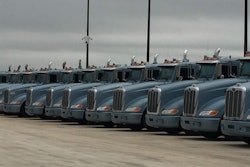Over independent owner-operator Zach Beadle’s career of nearly three decades, he’s amassed quite a collection of keys – more than one for every year in business. As Overdrive Senior Editor Todd Dills wrote in this month’s edition of CCJ sister publication Overdrive, those keys “don’t turn the ignitions for any big collection of trucks. Beadle’s been running since the late 1980s in the same 1976 Peterbilt cabover, hauling livestock, hay, heavy equipment, liquid feed and fertilizer, using trailers he owns.”
“Those keys go to people’s ranch houses,” says the Devine, Texas-based owner-operator. “They go to packing houses where they give you a key to go in at night and unload your cattle” – and more.
Though Beadle doesn’t use all of them today, their place in the cab where he conducts his business in large part is a reminder of where he’s been. They also reinforce what he believes about success: “The gut of who a person is. If they’re honest, and they look for ways to go the extra mile” for the customer, then trust, respect and dollars will follow.
Seen from that customer’s perspective, and despite the prevailing counter-sentiment, “shippers have long memories,” says Gail Rutkowski, executive director of the National Shippers Strategic Transportation Council, whose members work in manufacturers’ transportation departments.
Over time, Rutkowski says, the freight marketplace has become more of a seller’s market. Though capacity hasn’t been nearly as tight through the last year as it was the prior year, pressures continue to mount in a variety of sectors.
Now is a great time for small carriers to “go out and approach the shipper,” she says. “Shippers are looking for those carriers. That’s the reason they so often turn to brokers – they don’t have the bandwidth to go out search for those smaller carriers.”
Via the stories that are part of Overdrive‘s package of reports, linked below, find avenues to take in searching for shippers, as well as tactics for building a customer base for the long term.

“Why you?” — your distinguishing factor could take many forms, as several examples here illustrate.
Defining competitive factors: What about price?
Whether you’re better at “sharpening your pencil” than the competition or you’re the “high-end” carrier with a specialized service, don’t sell yourself short in today’s market on rates. …
Work the relationship for the long term
Working the spot market via load boards, the fallback of many a small fleet, you may never lay eyes on the face of the freight broker. By contrast, going after direct shipper contracts is an exercise in long-term relationship building.










